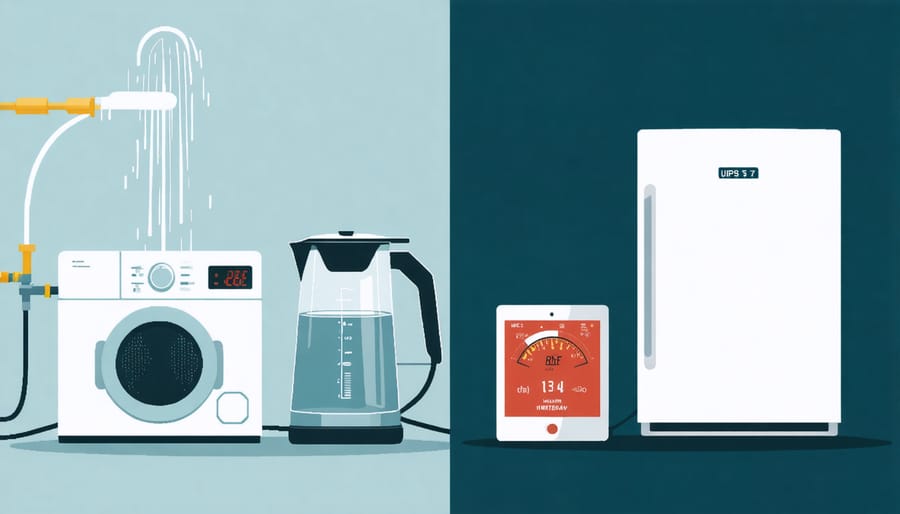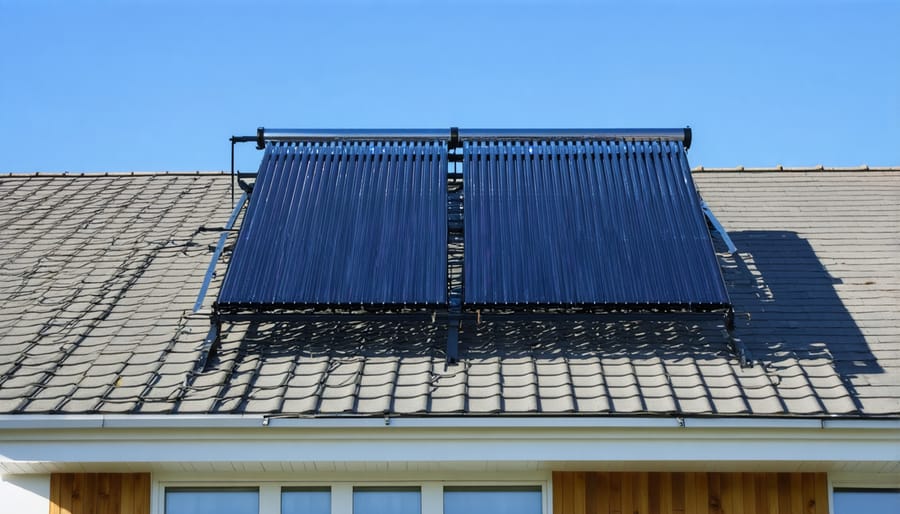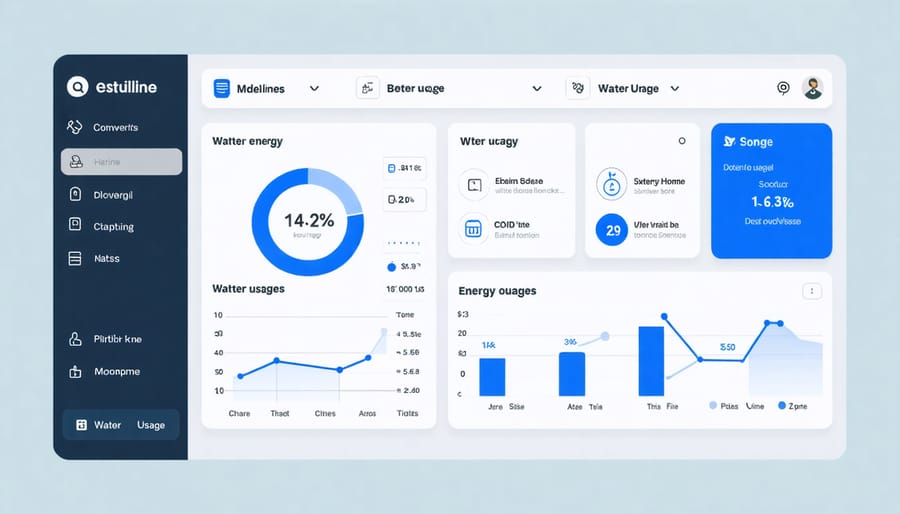Transform your home into a water-energy efficiency powerhouse by integrating sustainable home solutions that address both resources simultaneously. Every drop of water saved translates to energy conserved, creating a powerful ripple effect in both utility bills and environmental impact. Modern homes waste up to 30% of water-energy resources through inefficient systems, but smart design choices can slash this waste while enhancing comfort. By understanding the intricate dance between water and energy consumption – from hot water heating to landscape irrigation – homeowners can implement practical solutions that maximize efficiency in both domains. Whether you’re building new or retrofitting an existing home, the water-energy nexus offers a blueprint for creating spaces that work smarter, not harder, using innovative technologies and time-tested techniques that deliver measurable results.
How Your Home’s Water Use Impacts Your Energy Bills
Hot Water Systems: The Hidden Energy Drain
Did you know that your water heater could be silently consuming up to 18% of your home’s total energy? It’s one of those appliances we rarely think about until we’re hit with a cold shower or a shocking utility bill. Traditional tank water heaters keep gallons of water hot 24/7, even when you’re sleeping or away at work.
The real energy drain comes from standby heat loss – that’s when heat escapes from your stored hot water into the surrounding air. Think of it like leaving a hot cup of coffee out – it eventually cools down, requiring more energy to heat it back up. Modern homes often have multiple bathrooms and appliances demanding hot water simultaneously, which can lead to even greater energy consumption.
But here’s the good news: understanding your hot water system is the first step toward optimization. Simple actions like insulating your water heater, setting the temperature to 120°F (49°C), and fixing leaky faucets can significantly reduce both water and energy waste. For those ready to make bigger changes, tankless water heaters and solar thermal systems offer exciting alternatives that can slash your energy usage while ensuring you never run out of hot water.
Appliance Double Impact
Your household appliances are silent contributors to both your water and energy bills, creating a double impact on your monthly expenses. Take your washing machine, for instance – it not only uses water for cleaning but also requires significant energy to heat that water and run the motor. The same goes for your dishwasher, which typically uses both hot water and electricity for each cycle.
The most surprising dual consumer might be your water heater, which accounts for about 18% of your home’s energy use while providing hot water throughout your home. Even your toilet, though not requiring electricity directly, impacts your local water treatment facility’s energy consumption.
Being mindful of this connection can lead to smarter choices. Opting for ENERGY STAR certified appliances can reduce both water and energy consumption by 20-50% compared to standard models. Simple habits like washing clothes in cold water, running full loads in dishwashers, and fixing leaky faucets can significantly lower both utility bills.
Remember, every drop of water saved also means energy saved, making water-efficient appliances a smart investment for both environmental and financial reasons.

Smart Design Features That Reduce Both Water and Energy Use
Efficient Plumbing Layout
A well-designed plumbing layout is a cornerstone of energy-efficient home design, playing a crucial role in reducing both water and energy waste. By strategically planning your pipe routes and fixture locations, you can significantly cut down on heat loss and pump energy requirements.
Start by keeping hot water pipes as short as possible between your water heater and frequently used fixtures like kitchen sinks and showers. This simple approach minimizes heat loss during water transport and reduces the wait time for hot water to reach your taps. Consider grouping water-using appliances and fixtures close together – for instance, positioning your washing machine near the water heater or stacking bathrooms vertically in multi-story homes.
Insulating your hot water pipes is another game-changer. This affordable solution helps maintain water temperature throughout the system, meaning less energy is needed to reheat water that’s cooled in the pipes. For existing homes, focus on accessible pipes in unheated areas like basements and crawl spaces.
Don’t forget about pipe sizing – larger diameter pipes might seem better, but they can actually waste more energy by holding excess water that needs heating. Work with a professional to determine the optimal pipe size for your home’s needs. Finally, consider installing a hot water recirculation system, which can eliminate water waste while waiting for hot water and reduce overall energy consumption.

Solar Water Heating Integration
Solar water heating systems offer an elegant solution to reduce both water and energy consumption in your home. These systems harness the sun’s energy to heat your water, cutting down on traditional energy costs while maintaining reliable hot water access throughout the year.
The basic setup includes solar collectors, typically mounted on your roof, which absorb sunlight and transfer that heat to a storage tank. The heated water can then be used directly or serve as a pre-heating system for your conventional water heater, significantly reducing its workload.
For maximum efficiency, consider positioning your collectors facing south with a tilt angle matching your latitude. In colder climates, opt for closed-loop systems that use antifreeze solution to prevent freezing. Warmer regions can benefit from simpler direct systems where household water flows directly through the collectors.
Integration tips for homeowners:
– Start with a professional energy audit to determine system size
– Install thermal storage tanks in insulated spaces
– Consider a backup heating system for cloudy days
– Regularly clean collector surfaces for optimal performance
– Monitor system performance through smart meters
While installation costs may seem substantial initially, solar water heating systems typically pay for themselves within 5-10 years through reduced utility bills. Plus, many regions offer tax incentives and rebates to offset installation costs, making this eco-friendly upgrade more accessible for homeowners.
Greywater Systems
Greywater systems are a smart solution that bridges the gap between water and energy efficiency in your home. These innovative systems capture and reuse gently used water from sinks, showers, and washing machines, turning what would be waste into a valuable resource. By implementing these systems, you can significantly reduce both your water consumption and the energy needed to heat and process water.
Think of greywater as your home’s secret sustainability weapon. Instead of sending perfectly usable water down the drain, you can redirect it to water your garden, flush toilets, or handle other non-potable needs. This clever approach is one of the most effective water conservation strategies you can adopt, potentially saving hundreds of gallons of water monthly.
The beauty of greywater systems lies in their flexibility. You can start small with a simple sink-to-toilet setup or go all-in with a comprehensive whole-house system. The energy savings come from reducing the need to heat fresh water for every use and decreasing the energy required to pump and treat water at municipal facilities.
Installing a greywater system doesn’t have to be overwhelming. Many homeowners start with basic DIY solutions, like redirecting washing machine water to the garden through food-safe hoses. Just remember to use biodegradable, plant-friendly soaps and cleaners to protect your soil and plants.
Smart Technology Solutions
Smart Meters and Monitoring
Ever wondered how much water and energy you’re really using at home? Smart meters and monitoring systems are game-changers in understanding and optimizing your resource consumption. These clever devices give you real-time insights into your water and energy usage patterns, helping you make smarter decisions about your home’s efficiency.
Modern smart meters can track everything from your shower duration to peak electricity usage times. Many come with user-friendly apps that display your consumption data in easy-to-understand graphs and charts. Imagine getting a gentle alert when you’ve left the sprinkler running too long or knowing exactly which appliances are energy hungry!
For water monitoring, flow sensors can detect leaks before they become costly problems, while pressure monitors help maintain optimal water pressure throughout your home. On the energy side, smart electrical meters can break down your power usage by appliance and time of day, making it easier to adjust your habits for maximum savings.
The real magic happens when these systems work together. For example, your smart water heater can learn your family’s hot water usage patterns and heat water only when needed, saving both water and energy. Many of these devices can be integrated with home automation systems, allowing you to monitor and control your resource usage from your smartphone.
By understanding your consumption patterns through smart monitoring, you can make informed decisions that benefit both your wallet and the environment.

Automated Control Systems
Today’s smart home technology makes it easier than ever to manage your water and energy usage effectively. Automated control systems act as your home’s brain, continuously monitoring and optimizing both water and energy consumption without sacrificing comfort or convenience.
Modern smart thermostats can learn your schedule and adjust heating and cooling accordingly, while smart water heaters can reduce energy waste by heating water only when needed. These systems often come with user-friendly apps that provide real-time insights into your usage patterns and suggest ways to improve efficiency.
One of the most impactful features is automated leak detection. Smart water sensors can identify even minor leaks before they become major problems, potentially saving thousands of gallons of water and preventing energy waste from hot water systems. Similarly, smart irrigation systems adjust watering schedules based on weather conditions and soil moisture levels, ensuring your garden gets exactly what it needs.
For maximum efficiency, consider integrating these systems with smart lighting and appliance controls. For example, you can program your dishwasher to run during off-peak energy hours while maintaining optimal water temperature. Many systems also offer voice control through popular virtual assistants, making it simple to adjust settings or check consumption patterns.
The initial investment in automated controls typically pays for itself through reduced utility bills and prevented water damage, making it a smart choice for environmentally conscious homeowners.
DIY Water-Energy Efficiency Projects
Quick Fixes
Want to make an immediate impact on your water-energy footprint? Start with these simple yet effective fixes that you can implement today. Install low-flow aerators on your faucets and showerheads to reduce hot water usage without compromising pressure. Replace old washers and fix leaky faucets – even a small drip wastes both water and the energy used to heat it.
Set your water heater temperature to 120°F (49°C) for optimal efficiency and safety. Insulate your hot water pipes with foam sleeves, especially in unheated areas, to prevent heat loss and reduce the energy needed to maintain hot water temperature. Consider installing a timer on your water heater to turn it off during periods when you typically don’t use hot water.
For immediate savings, start taking shorter showers and only run full loads in your dishwasher and washing machine. Use cold water for laundry when possible, and air-dry clothes when weather permits. These simple changes require minimal investment but can lead to significant reductions in both your water and energy bills.
Remember to regularly clean your appliances’ filters and check for leaks around toilets and under sinks. These quick maintenance tasks help ensure your water-using appliances operate at peak efficiency.
Weekend Projects
Ready to take your water-energy conservation efforts to the next level? These eco-friendly DIY projects can make a significant impact on both your utility bills and environmental footprint.
Install a rainwater harvesting system by connecting your downspouts to storage tanks. This weekend project requires basic plumbing skills and can provide free water for garden irrigation and outdoor cleaning. For energy savings, consider installing a solar water heater for your pool or hot tub – a project that typically pays for itself within two years.
Create a greywater recycling system by redirecting water from your washing machine to your garden. You’ll need to install proper filtration and ensure compliance with local regulations, but the savings are worth the effort.
For tech-savvy DIYers, set up a smart home water and energy monitoring system. Connect flow meters to main water lines and install energy monitors on major appliances. This gives you real-time insights into your usage patterns and helps identify opportunities for further savings.
Remember to research local building codes and consider consulting a professional for guidance before starting these projects.
The connection between water and energy in our homes is more significant than many of us realize, but the good news is that we can all make a positive impact. By implementing the strategies we’ve discussed, from installing water-efficient fixtures to optimizing your hot water system, you’re not just saving money – you’re contributing to a more sustainable future.
Remember that every small change matters. Starting with simple steps like fixing leaks and insulating pipes can lead to substantial savings in both water and energy consumption. As you become more comfortable with these basics, you can gradually tackle bigger projects like installing smart home systems or upgrading to energy-efficient appliances.
Keep in mind that the water-energy nexus isn’t just about conservation – it’s about creating a more comfortable and efficient living space. By making thoughtful choices about your home’s water and energy systems, you’re investing in both your property’s value and the environment.
Take action today by starting with one or two manageable changes. Monitor your utility bills to track your progress, and don’t hesitate to consult with professionals for more complex modifications. Together, we can create homes that are not only more sustainable but also more enjoyable to live in.
The future of sustainable home design lies in understanding and optimizing the water-energy connection. Your efforts, combined with those of your community, can make a real difference in creating a more sustainable world for generations to come.
